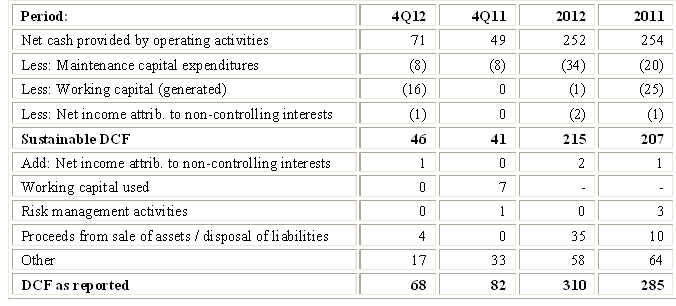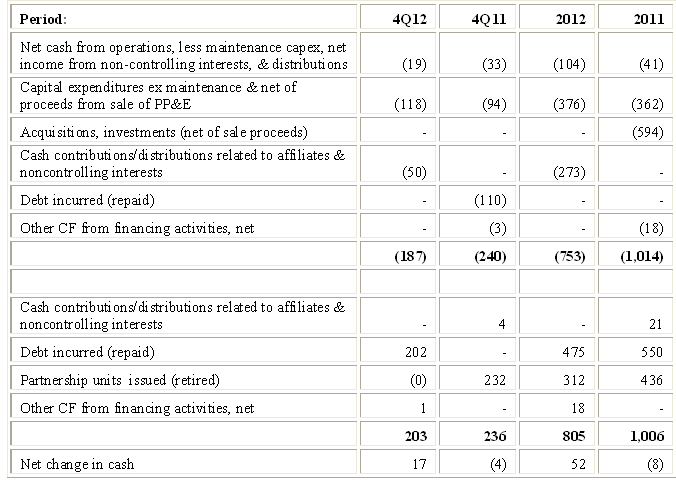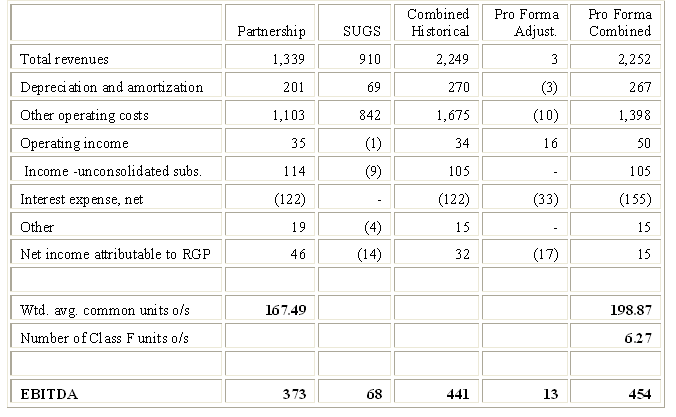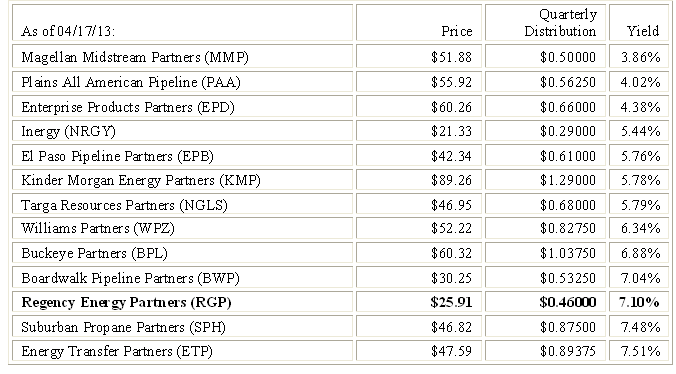Revenues, operating income, net income and earnings before interest, depreciation and amortization and income tax expenses (EBITDA) reported by Regency Energy Partners LP (RGP) for 4Q12, 4Q11 and for 2010-2012 are summarized in Table 1 below:

In 4Q12 and 2012, operating income, net income and EBITDA decreased vs. the corresponding prior year periods (the decrease in EBITDA in 2012 vs. 2011 is on a per unit, not absolute, basis).
In 4Q12 RGP redefined its business segments and restated segment information for earlier periods. Its 2012 and prior year results were revised to reflect this new segment alignment. The principal change was to disaggregate what was formerly the Joint Ventures (“JVs”) segment and allocate the JVs operations to other segments.
Segments will again have to be realigned following the February 2013 announcement that RGP will acquire Southern Union Gathering Company, LLC, the owner of Southern Union Gas Services, Ltd. (“SUGS”), from Southern Union Company, a jointly owned affiliate of Energy Transfer Equity, L.P. (ETE) and Energy Transfer Partners, L.P. (ETP). The $1.5 billion acquisition will significantly expand RGP’s presence in the Permian Basin (west Texas) and is expected to close by 6/30/13.
As of 12/31/13, RGP was organized according to the following 5 business segments:
(1) Gathering and Processing provides “wellhead-to-market” services to producers of natural gas. This segment also includes RGP’s 33.33% membership interest in Ranch JV, which processes natural gas delivered from shale formations in west Texas;
(2) Natural Gas Transportation includes a 49.99% general partner interest in RIGS Haynesville Partnership Co.,(“HPC”), which owns a 450 mile intrastate pipeline that delivers natural gas from northwest Louisiana to downstream pipelines and markets; a 50% membership interest in Midcontinent Express Pipeline LLC (“MEP”), which owns an interstate natural gas pipeline with approximately 500 miles stretching from southeast Oklahoma through northeast Texas, northern Louisiana and central Mississippi to an interconnect with the Transcontinental Gas Pipe Line system in Butler, Alabama; and Gulf States, a small (10-mile), wholly–owned, regulated, interstate pipeline that extends from Harrison County, Texas to Caddo Parish, Louisiana.
(3) NGL Services includes the 30% membership interest in Lone Star, an entity owning a diverse set of midstream energy assets including NGL pipelines, storage, fractionation and processing facilities located in the states of Texas, Mississippi and Louisiana.
(4) Contract Services operates a fleet of compressors used to provide turn-key natural gas compression services and a fleet of equipment used to provide treating services, such as carbon dioxide and hydrogen sulfide removal, natural gas cooling, dehydration and BTU management, to natural gas producers and midstream pipeline companies; and
(5) Corporate comprises RGP’s corporate offices.
RGP uses “Segment margin” as one of its key metrics to measure operating performance. Segment margin is roughly equal to revenues less cost of sales. Segment margins for 4Q12, 4Q11 and for 2010-2012 are summarized in Table 2 below:

The decreases vs. the corresponding prior year periods in operating income, net income and EBITDA noted with respect to Table 1 occurred despite the improvement in total segment margins shown in Table 2. This is principally due to higher operations & maintenance charges and to higher depreciation charges.
Income from unconsolidated affiliates (the JVs) in 4Q12 vs. 4Q11 and in 2010-2012 vs. 2011is summarized in Table 3 below:

As indicated by Table 3, the primary drivers of the improvement in total income from unconsolidated joint ventures in 2012 vs. 2011 is Lone Star which became operational in May 2011. Lone Star provided a twelve month contribution in 2012 vs. a ~7 month contribution in 2011. On the other hand, HPC was adversely affected by the expiration of certain contracts not renewed and lower throughput. The primary reason given by shippers for not renewing their contracts is that they hold excess firm transportation capacity out of the Haynesville shale. This excess capacity is a result of moving drilling rigs out of the Haynesville area to richer gas plays which has slowed supply growth and contributed to a decrease in throughput.
RGP’s definition of Distributable Cash Flow (“DCF”) and a comparison to definitions used by other master limited partnerships (“MLPs”) are described in an article titled Distributable Cash Flow (“DCF”). Using that definition, DCF for 2012 was $310 million ($1.85 per unit), down from $285 million ($1.96 per unit) in 2011.
As always, I first attempt to assess how these DCF figures compare with what I call sustainable DCF for these periods and whether distributions were funded by additional debt or issuing additional units. Given quarterly fluctuations in revenues, working capital needs and other items, a review of trailing 12 months (“TTM”) or annual numbers tends to be more meaningful than quarterly numbers for the purpose of analyzing changes in reported and sustainable distributable cash flows. However, I present both.
The generic reasons why DCF as reported by the MLP may differ from sustainable DCF are reviewed in an article titled Estimating sustainable DCF- why and how. Applying the method described there to RGP’s results generates the comparison outlined in Table 4 below:

The principal differences between reported DCF and sustainable DCF relate to proceeds from asset sales and items grouped under “Other." The latter incorporates RGP’s substantial, but non-controlling, stakes in the JVs.
I do not regard proceeds from asset sales as a sustainable source of DCF and therefore exclude them from my definition of sustainable DCF.
The largest variance between reported and sustainable DCF is related to RGP’s substantial, but non-controlling, stakes in the JV entities. Pursuant to Generally Accepted Accounting Principles (GAAP), RGP records its share of the net income in these other pipelines as income from unconsolidated affiliates in accordance with the equity method of accounting. However, for purposes of calculating DCF, RGP treats these as if they were fully consolidated by deducting its share of net income, adding its share of the EBITDA, and further adjusting to take into account its share of interest expense and maintenance capital expenditures.
On the one hand, I can accept classifying RGP’s share of cash flows generated from the JV entities in the sustainable category despite the fact that RGP does not control them (i.e., cannot determine what to do with the cash they generate). This is because they are similar in every other respect to RGP’s other pipeline assets and because RGP and/or ETE, RGP’s general partner, do exercise a significant degree of influence over them. On the other hand, RGP’s share of cash flows generated from the JV entities (which accounts for the bulk of the “Other” line item totaling $58 million in 2012 and $64 million in 2011) does not, as of the date of the report, appear on RGP's balance sheet and does not increase RGP’s end-of-period cash balance.
Coverage ratios, with and without this line item, are as indicated in the table below:

Whichever way you look at it, these are thin coverage ratios.
I find it helpful to look at a simplified cash flow statement by netting certain items (e.g., acquisitions against dispositions) and by separating cash generation from cash consumption.
Here is what I see for RGP:
Simplified Sources and Uses of Funds

Net cash from operations, less maintenance capital expenditures, less net income from non-controlling interests did not cover distributions in both periods. The shortfall amounted to $104 million in 2012 and $41 million in 2011. Table 6 therefore shows that distributions in 2012 and 2011 were partially financed by issuing equity and debt.
The 2013 numbers will be significantly impacted by the $1.5 billion SUGS acquisition. Some analysts project SUGS will generate $115 million in EBITDA in 2013, which would mean SUGS is being priced at a high multiple (~13x) of EBITDA. But based unaudited pro-forma combined statement of operations for 2012 assuming the acquisition had occurred on January 1, 2012, the price being paid by RGP appears even richer. The pro-forma analysis was provided on April 12, 2013, and takes into consideration that the SUGS acquisition will be financed by issuing $900 million of units to ETP (of which $150 million will be Class F units that will be equivalent to the common units but will not receive distributions for 8 consecutive quarters post-transaction closing) and by paying $600 million in cash. It also takes into consideration ETE’s agreement to eliminate the $10 million annual management fee paid by RGP for two years post-transaction close.
Table 7 below provides a summary of these pro-forma numbers (to which I added my estimate of EBITDA):

As shown in Table 7, on a pro-forma basis EBITDA would have increased by ~$81 million. A shortfall results after subtracting from that $33 million of additional interest payments and ~$58 million of additional distributions (due to the higher number of units outstanding). There would be an accretion (rather than shortfall or dilution) if SUGS were indeed to generate EBITDA of $115 million in 2013, but it would be minimal and only thanks to the temporary (2-year) waivers by ETE of its entitlement to management fees and to incentive distribution rights (“IDRs”) with respect to common units issued in connection with this transaction. In my opinion, SUGS is unlikely to contribute much to RGP’s ability to increase distributions over the next 2-3 years.
Table 8 below compares RGP’s current yield of some of the other MLPs I follow:

ETE, RGP’s general partner, holds ~15% of the limited partner units (as of 12/31/12) and is entitled, via its IDRs, to receive ~$0.039 every time RGP makes a quarterly distribution of $0.46 per unit. While distributions have not grown since 1Q12, investors should be aware that if they increase modestly, ETE’s share will increase rapidly. For example, if quarterly distributions increase by $0.065 (14.1%), ETE’s quarterly IDR distributions will increase by ~74%. RGP is at a significant disadvantage in terms of cost of capital compared to MLPs who have eliminated IDRs altogether. RGP is also burdened by a higher level of debt to EBITDA than most of MLPs I follow. Total long-term debt stood at $2.1 billion as of 12/31/12, a multiple of 5.65x EBITDA for the trailing 12-months. In light of the low DCF coverage ratios, the relatively high leverage, the high price paid for SUGS, the low likelihood of a resumption of distribution growth, and my discomfort with the structural complexity surrounding ETE and ETP, I would not buy RGP despite the attractive yield and despite the potential for its acquisition by ETP.

In 4Q12 and 2012, operating income, net income and EBITDA decreased vs. the corresponding prior year periods (the decrease in EBITDA in 2012 vs. 2011 is on a per unit, not absolute, basis).
In 4Q12 RGP redefined its business segments and restated segment information for earlier periods. Its 2012 and prior year results were revised to reflect this new segment alignment. The principal change was to disaggregate what was formerly the Joint Ventures (“JVs”) segment and allocate the JVs operations to other segments.
Segments will again have to be realigned following the February 2013 announcement that RGP will acquire Southern Union Gathering Company, LLC, the owner of Southern Union Gas Services, Ltd. (“SUGS”), from Southern Union Company, a jointly owned affiliate of Energy Transfer Equity, L.P. (ETE) and Energy Transfer Partners, L.P. (ETP). The $1.5 billion acquisition will significantly expand RGP’s presence in the Permian Basin (west Texas) and is expected to close by 6/30/13.
As of 12/31/13, RGP was organized according to the following 5 business segments:
(1) Gathering and Processing provides “wellhead-to-market” services to producers of natural gas. This segment also includes RGP’s 33.33% membership interest in Ranch JV, which processes natural gas delivered from shale formations in west Texas;
(2) Natural Gas Transportation includes a 49.99% general partner interest in RIGS Haynesville Partnership Co.,(“HPC”), which owns a 450 mile intrastate pipeline that delivers natural gas from northwest Louisiana to downstream pipelines and markets; a 50% membership interest in Midcontinent Express Pipeline LLC (“MEP”), which owns an interstate natural gas pipeline with approximately 500 miles stretching from southeast Oklahoma through northeast Texas, northern Louisiana and central Mississippi to an interconnect with the Transcontinental Gas Pipe Line system in Butler, Alabama; and Gulf States, a small (10-mile), wholly–owned, regulated, interstate pipeline that extends from Harrison County, Texas to Caddo Parish, Louisiana.
(3) NGL Services includes the 30% membership interest in Lone Star, an entity owning a diverse set of midstream energy assets including NGL pipelines, storage, fractionation and processing facilities located in the states of Texas, Mississippi and Louisiana.
(4) Contract Services operates a fleet of compressors used to provide turn-key natural gas compression services and a fleet of equipment used to provide treating services, such as carbon dioxide and hydrogen sulfide removal, natural gas cooling, dehydration and BTU management, to natural gas producers and midstream pipeline companies; and
(5) Corporate comprises RGP’s corporate offices.
RGP uses “Segment margin” as one of its key metrics to measure operating performance. Segment margin is roughly equal to revenues less cost of sales. Segment margins for 4Q12, 4Q11 and for 2010-2012 are summarized in Table 2 below:

The decreases vs. the corresponding prior year periods in operating income, net income and EBITDA noted with respect to Table 1 occurred despite the improvement in total segment margins shown in Table 2. This is principally due to higher operations & maintenance charges and to higher depreciation charges.
Income from unconsolidated affiliates (the JVs) in 4Q12 vs. 4Q11 and in 2010-2012 vs. 2011is summarized in Table 3 below:

As indicated by Table 3, the primary drivers of the improvement in total income from unconsolidated joint ventures in 2012 vs. 2011 is Lone Star which became operational in May 2011. Lone Star provided a twelve month contribution in 2012 vs. a ~7 month contribution in 2011. On the other hand, HPC was adversely affected by the expiration of certain contracts not renewed and lower throughput. The primary reason given by shippers for not renewing their contracts is that they hold excess firm transportation capacity out of the Haynesville shale. This excess capacity is a result of moving drilling rigs out of the Haynesville area to richer gas plays which has slowed supply growth and contributed to a decrease in throughput.
RGP’s definition of Distributable Cash Flow (“DCF”) and a comparison to definitions used by other master limited partnerships (“MLPs”) are described in an article titled Distributable Cash Flow (“DCF”). Using that definition, DCF for 2012 was $310 million ($1.85 per unit), down from $285 million ($1.96 per unit) in 2011.
As always, I first attempt to assess how these DCF figures compare with what I call sustainable DCF for these periods and whether distributions were funded by additional debt or issuing additional units. Given quarterly fluctuations in revenues, working capital needs and other items, a review of trailing 12 months (“TTM”) or annual numbers tends to be more meaningful than quarterly numbers for the purpose of analyzing changes in reported and sustainable distributable cash flows. However, I present both.
The generic reasons why DCF as reported by the MLP may differ from sustainable DCF are reviewed in an article titled Estimating sustainable DCF- why and how. Applying the method described there to RGP’s results generates the comparison outlined in Table 4 below:

The principal differences between reported DCF and sustainable DCF relate to proceeds from asset sales and items grouped under “Other." The latter incorporates RGP’s substantial, but non-controlling, stakes in the JVs.
I do not regard proceeds from asset sales as a sustainable source of DCF and therefore exclude them from my definition of sustainable DCF.
The largest variance between reported and sustainable DCF is related to RGP’s substantial, but non-controlling, stakes in the JV entities. Pursuant to Generally Accepted Accounting Principles (GAAP), RGP records its share of the net income in these other pipelines as income from unconsolidated affiliates in accordance with the equity method of accounting. However, for purposes of calculating DCF, RGP treats these as if they were fully consolidated by deducting its share of net income, adding its share of the EBITDA, and further adjusting to take into account its share of interest expense and maintenance capital expenditures.
On the one hand, I can accept classifying RGP’s share of cash flows generated from the JV entities in the sustainable category despite the fact that RGP does not control them (i.e., cannot determine what to do with the cash they generate). This is because they are similar in every other respect to RGP’s other pipeline assets and because RGP and/or ETE, RGP’s general partner, do exercise a significant degree of influence over them. On the other hand, RGP’s share of cash flows generated from the JV entities (which accounts for the bulk of the “Other” line item totaling $58 million in 2012 and $64 million in 2011) does not, as of the date of the report, appear on RGP's balance sheet and does not increase RGP’s end-of-period cash balance.
Coverage ratios, with and without this line item, are as indicated in the table below:

Whichever way you look at it, these are thin coverage ratios.
I find it helpful to look at a simplified cash flow statement by netting certain items (e.g., acquisitions against dispositions) and by separating cash generation from cash consumption.
Here is what I see for RGP:
Simplified Sources and Uses of Funds

Net cash from operations, less maintenance capital expenditures, less net income from non-controlling interests did not cover distributions in both periods. The shortfall amounted to $104 million in 2012 and $41 million in 2011. Table 6 therefore shows that distributions in 2012 and 2011 were partially financed by issuing equity and debt.
The 2013 numbers will be significantly impacted by the $1.5 billion SUGS acquisition. Some analysts project SUGS will generate $115 million in EBITDA in 2013, which would mean SUGS is being priced at a high multiple (~13x) of EBITDA. But based unaudited pro-forma combined statement of operations for 2012 assuming the acquisition had occurred on January 1, 2012, the price being paid by RGP appears even richer. The pro-forma analysis was provided on April 12, 2013, and takes into consideration that the SUGS acquisition will be financed by issuing $900 million of units to ETP (of which $150 million will be Class F units that will be equivalent to the common units but will not receive distributions for 8 consecutive quarters post-transaction closing) and by paying $600 million in cash. It also takes into consideration ETE’s agreement to eliminate the $10 million annual management fee paid by RGP for two years post-transaction close.
Table 7 below provides a summary of these pro-forma numbers (to which I added my estimate of EBITDA):

As shown in Table 7, on a pro-forma basis EBITDA would have increased by ~$81 million. A shortfall results after subtracting from that $33 million of additional interest payments and ~$58 million of additional distributions (due to the higher number of units outstanding). There would be an accretion (rather than shortfall or dilution) if SUGS were indeed to generate EBITDA of $115 million in 2013, but it would be minimal and only thanks to the temporary (2-year) waivers by ETE of its entitlement to management fees and to incentive distribution rights (“IDRs”) with respect to common units issued in connection with this transaction. In my opinion, SUGS is unlikely to contribute much to RGP’s ability to increase distributions over the next 2-3 years.
Table 8 below compares RGP’s current yield of some of the other MLPs I follow:

ETE, RGP’s general partner, holds ~15% of the limited partner units (as of 12/31/12) and is entitled, via its IDRs, to receive ~$0.039 every time RGP makes a quarterly distribution of $0.46 per unit. While distributions have not grown since 1Q12, investors should be aware that if they increase modestly, ETE’s share will increase rapidly. For example, if quarterly distributions increase by $0.065 (14.1%), ETE’s quarterly IDR distributions will increase by ~74%. RGP is at a significant disadvantage in terms of cost of capital compared to MLPs who have eliminated IDRs altogether. RGP is also burdened by a higher level of debt to EBITDA than most of MLPs I follow. Total long-term debt stood at $2.1 billion as of 12/31/12, a multiple of 5.65x EBITDA for the trailing 12-months. In light of the low DCF coverage ratios, the relatively high leverage, the high price paid for SUGS, the low likelihood of a resumption of distribution growth, and my discomfort with the structural complexity surrounding ETE and ETP, I would not buy RGP despite the attractive yield and despite the potential for its acquisition by ETP.
